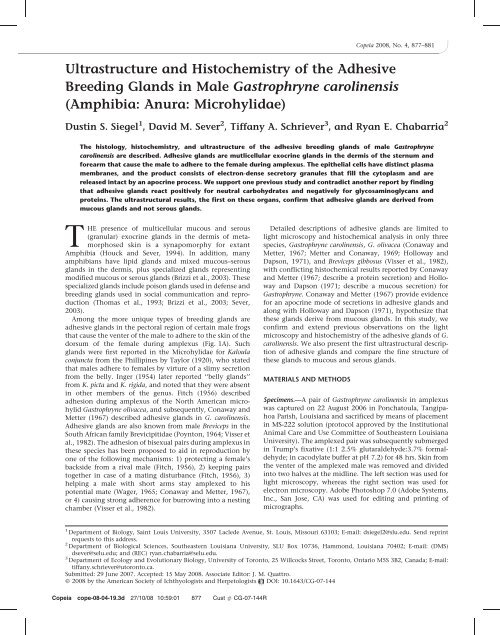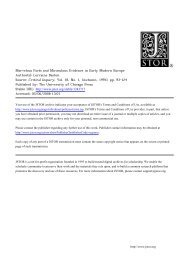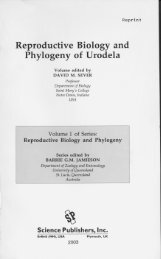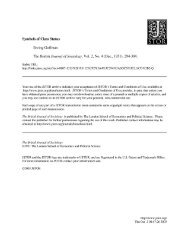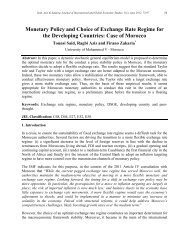Ultrastructure and Histochemistry of the Adhesive Breeding Glands ...
Ultrastructure and Histochemistry of the Adhesive Breeding Glands ...
Ultrastructure and Histochemistry of the Adhesive Breeding Glands ...
Create successful ePaper yourself
Turn your PDF publications into a flip-book with our unique Google optimized e-Paper software.
<strong>Ultrastructure</strong> <strong>and</strong> <strong>Histochemistry</strong> <strong>of</strong> <strong>the</strong> <strong>Adhesive</strong><br />
<strong>Breeding</strong> Gl<strong>and</strong>s in Male Gastrophryne carolinensis<br />
(Amphibia: Anura: Microhylidae)<br />
Dustin S. Siegel 1 , David M. Sever 2 , Tiffany A. Schriever 3 , <strong>and</strong> Ryan E. Chabarria 2<br />
The histology, histochemistry, <strong>and</strong> ultrastructure <strong>of</strong> <strong>the</strong> adhesive breeding gl<strong>and</strong>s <strong>of</strong> male Gastrophryne<br />
carolinensis are described. <strong>Adhesive</strong> gl<strong>and</strong>s are mutlicellular exocrine gl<strong>and</strong>s in <strong>the</strong> dermis <strong>of</strong> <strong>the</strong> sternum <strong>and</strong><br />
forearm that cause <strong>the</strong> male to adhere to <strong>the</strong> female during amplexus. The epi<strong>the</strong>lial cells have distinct plasma<br />
membranes, <strong>and</strong> <strong>the</strong> product consists <strong>of</strong> electron-dense secretory granules that fill <strong>the</strong> cytoplasm <strong>and</strong> are<br />
released intact by an apocrine process. We support one previous study <strong>and</strong> contradict ano<strong>the</strong>r report by finding<br />
that adhesive gl<strong>and</strong>s react positively for neutral carbohydrates <strong>and</strong> negatively for glycosaminoglycans <strong>and</strong><br />
proteins. The ultrastructural results, <strong>the</strong> first on <strong>the</strong>se organs, confirm that adhesive gl<strong>and</strong>s are derived from<br />
mucous gl<strong>and</strong>s <strong>and</strong> not serous gl<strong>and</strong>s.<br />
THE presence <strong>of</strong> multicellular mucous <strong>and</strong> serous<br />
(granular) exocrine gl<strong>and</strong>s in <strong>the</strong> dermis <strong>of</strong> metamorphosed<br />
skin is a synapomorphy for extant<br />
Amphibia (Houck <strong>and</strong> Sever, 1994). In addition, many<br />
amphibians have lipid gl<strong>and</strong>s <strong>and</strong> mixed mucous–serous<br />
gl<strong>and</strong>s in <strong>the</strong> dermis, plus specialized gl<strong>and</strong>s representing<br />
modified mucous or serous gl<strong>and</strong>s (Brizzi et al., 2003). These<br />
specialized gl<strong>and</strong>s include poison gl<strong>and</strong>s used in defense <strong>and</strong><br />
breeding gl<strong>and</strong>s used in social communication <strong>and</strong> reproduction<br />
(Thomas et al., 1993; Brizzi et al., 2003; Sever,<br />
2003).<br />
Among <strong>the</strong> more unique types <strong>of</strong> breeding gl<strong>and</strong>s are<br />
adhesive gl<strong>and</strong>s in <strong>the</strong> pectoral region <strong>of</strong> certain male frogs<br />
that cause <strong>the</strong> venter <strong>of</strong> <strong>the</strong> male to adhere to <strong>the</strong> skin <strong>of</strong> <strong>the</strong><br />
dorsum <strong>of</strong> <strong>the</strong> female during amplexus (Fig. 1A). Such<br />
gl<strong>and</strong>s were first reported in <strong>the</strong> Microhylidae for Kaloula<br />
conjuncta from <strong>the</strong> Phillipines by Taylor (1920), who stated<br />
that males adhere to females by virture <strong>of</strong> a slimy secretion<br />
from <strong>the</strong> belly. Inger (1954) later reported ‘‘belly gl<strong>and</strong>s’’<br />
from K. picta <strong>and</strong> K. rigida, <strong>and</strong> noted that <strong>the</strong>y were absent<br />
in o<strong>the</strong>r members <strong>of</strong> <strong>the</strong> genus. Fitch (1956) described<br />
adhesion during amplexus <strong>of</strong> <strong>the</strong> North American microhylid<br />
Gastrophryne olivacea, <strong>and</strong> subsequently, Conaway <strong>and</strong><br />
Metter (1967) described adhesive gl<strong>and</strong>s in G. carolinensis.<br />
<strong>Adhesive</strong> gl<strong>and</strong>s are also known from male Breviceps in <strong>the</strong><br />
South African family Brevicipitidae (Poynton, 1964; Visser et<br />
al., 1982). The adhesion <strong>of</strong> bisexual pairs during amplexus in<br />
<strong>the</strong>se species has been proposed to aid in reproduction by<br />
one <strong>of</strong> <strong>the</strong> following mechanisms: 1) protecting a female’s<br />
backside from a rival male (Fitch, 1956), 2) keeping pairs<br />
toge<strong>the</strong>r in case <strong>of</strong> a mating disturbance (Fitch, 1956), 3)<br />
helping a male with short arms stay amplexed to his<br />
potential mate (Wager, 1965; Conaway <strong>and</strong> Metter, 1967),<br />
or 4) causing strong adherence for burrowing into a nesting<br />
chamber (Visser et al., 1982).<br />
Copeia cope-08-04-19.3d 27/10/08 10:59:01 877 Cust # CG-07-144R<br />
Detailed descriptions <strong>of</strong> adhesive gl<strong>and</strong>s are limited to<br />
light microscopy <strong>and</strong> histochemical analysis in only three<br />
species, Gastrophryne carolinensis, G. olivacea (Conaway <strong>and</strong><br />
Metter, 1967; Metter <strong>and</strong> Conaway, 1969; Holloway <strong>and</strong><br />
Dapson, 1971), <strong>and</strong> Breviceps gibbosus (Visser et al., 1982),<br />
with conflicting histochemical results reported by Conaway<br />
<strong>and</strong> Metter (1967; describe a protein secretion) <strong>and</strong> Holloway<br />
<strong>and</strong> Dapson (1971; describe a mucous secretion) for<br />
Gastrophryne. Conaway <strong>and</strong> Metter (1967) provide evidence<br />
for an apocrine mode <strong>of</strong> secretions in adhesive gl<strong>and</strong>s <strong>and</strong><br />
along with Holloway <strong>and</strong> Dapson (1971), hypo<strong>the</strong>size that<br />
<strong>the</strong>se gl<strong>and</strong>s derive from mucous gl<strong>and</strong>s. In this study, we<br />
confirm <strong>and</strong> extend previous observations on <strong>the</strong> light<br />
microscopy <strong>and</strong> histochemistry <strong>of</strong> <strong>the</strong> adhesive gl<strong>and</strong>s <strong>of</strong> G.<br />
carolinensis. We also present <strong>the</strong> first ultrastructural description<br />
<strong>of</strong> adhesive gl<strong>and</strong>s <strong>and</strong> compare <strong>the</strong> fine structure <strong>of</strong><br />
<strong>the</strong>se gl<strong>and</strong>s to mucous <strong>and</strong> serous gl<strong>and</strong>s.<br />
MATERIALS AND METHODS<br />
Copeia 2008, No. 4, 877–881<br />
Specimens.—A pair <strong>of</strong> Gastrophryne carolinensis in amplexus<br />
was captured on 22 August 2006 in Ponchatoula, Tangipahoa<br />
Parish, Louisiana <strong>and</strong> sacrificed by means <strong>of</strong> placement<br />
in MS-222 solution (protocol approved by <strong>the</strong> Institutional<br />
Animal Care <strong>and</strong> Use Committee <strong>of</strong> Sou<strong>the</strong>astern Louisiana<br />
University). The amplexed pair was subsequently submerged<br />
in Trump’s fixative (1:1 2.5% glutaraldehyde:3.7% formaldehyde;<br />
in cacodylate buffer at pH 7.2) for 48 hrs. Skin from<br />
<strong>the</strong> venter <strong>of</strong> <strong>the</strong> amplexed male was removed <strong>and</strong> divided<br />
into two halves at <strong>the</strong> midline. The left section was used for<br />
light microscopy, whereas <strong>the</strong> right section was used for<br />
electron microscopy. Adobe Photoshop 7.0 (Adobe Systems,<br />
Inc., San Jose, CA) was used for editing <strong>and</strong> printing <strong>of</strong><br />
micrographs.<br />
1<br />
Department <strong>of</strong> Biology, Saint Louis University, 3507 Laclede Avenue, St. Louis, Missouri 63103; E-mail: dsiegel2@slu.edu. Send reprint<br />
requests to this address.<br />
2<br />
Department <strong>of</strong> Biological Sciences, Sou<strong>the</strong>astern Louisiana University, SLU Box 10736, Hammond, Louisiana 70402; E-mail: (DMS)<br />
dsever@selu.edu; <strong>and</strong> (REC) ryan.chabarria@selu.edu.<br />
3<br />
Department <strong>of</strong> Ecology <strong>and</strong> Evolutionary Biology, University <strong>of</strong> Toronto, 25 Willcocks Street, Toronto, Ontario M5S 3B2, Canada; E-mail:<br />
tiffany.schriever@utoronto.ca.<br />
Submitted: 29 June 2007. Accepted: 15 May 2008. Associate Editor: J. M. Quattro.<br />
F 2008 by <strong>the</strong> American Society <strong>of</strong> Ichthyologists <strong>and</strong> Herpetologists DOI: 10.1643/CG-07-144
878 Copeia 2008, No. 4<br />
Light microscopy.—Tissues from <strong>the</strong> left half <strong>of</strong> <strong>the</strong> venter<br />
were rinsed for 1 hr in tap water <strong>and</strong> dehydrated in a graded<br />
series <strong>of</strong> ethanol (70%, 95%, for 1 hr each, 100%, two cycles<br />
for 30 min each). Tissues were <strong>the</strong>n placed in toluene (two<br />
cycles for 30 min each) <strong>and</strong> subsequently embedded in<br />
paraffin blocks for sectioning with a MR3 (Research <strong>and</strong><br />
Manufacturing Co., Tucson, AZ) microtome. Sections<br />
10 micrometers (mm) thick were cut <strong>and</strong> affixed to albumenized<br />
slides. Alternate slides were stained with hematoxylineosin<br />
(H&E) for general histological examination, alcian<br />
blue 8GX (AB) at pH 2.5 for carboxylated glycosaminoglycans<br />
<strong>and</strong> periodic acid-Schiff’s (PAS) for neutral carbohydrates<br />
or bromophenol blue (BB) for proteins. All histological<br />
techniques followed Kiernan (1990). Slides were viewed<br />
under a Leica DM2000 (Leica Microsystems, Wetzlar,<br />
Germany) microscope, <strong>and</strong> images were obtained via a Leica<br />
DFC420 (Leica Microsystems, Wetzlar, Germany) digital<br />
camera.<br />
Electron microscopy.—Tissues from <strong>the</strong> right half <strong>of</strong> <strong>the</strong><br />
venter were rinsed in deionized water <strong>and</strong> <strong>the</strong>n post-fixed<br />
for 90 min in 2% osmium tetroxide. Tissues were subsequently<br />
rinsed in deionized water, dehydrated with a graded<br />
series <strong>of</strong> ethanol (70%, 95%, 100%, for 1 hr each), soaked<br />
30 min each in 1:1 100% ethanol:propylene oxide followed<br />
by pure propylene oxide, <strong>and</strong> embedded in an epoxy resin<br />
(EmBed 812, Electron Microscopy Sciences, Fort Washington,<br />
PA). Ultra-thin sections, at 70 nm, were achieved by use<br />
<strong>of</strong> DiATOME diamond knives (DiATOME, Biel, Switzerl<strong>and</strong>)<br />
on a RMC MT7 (Research <strong>and</strong> Manufacturing Co., Tucson,<br />
AZ) ultramicrotome. Ultra-thin sections were placed on<br />
copper grids <strong>and</strong> stained with uranyl acetate <strong>and</strong> lead<br />
citrate. Grids were viewed <strong>and</strong> photographed with a JEOL<br />
JEM 100S (JEOL USA, Peabody, MA) transmission electron<br />
microscope.<br />
RESULTS<br />
Histology <strong>and</strong> histochemistry.—Using Conaway <strong>and</strong> Metter<br />
(1967) as a guide, adhesive gl<strong>and</strong>s were located in <strong>the</strong> sternal<br />
region <strong>of</strong> Gastrophryne carolinensis <strong>and</strong> at <strong>the</strong> base <strong>of</strong> <strong>the</strong><br />
inner arm (Fig. 1B). In <strong>the</strong>se regions, adhesive gl<strong>and</strong>s are<br />
more numerous <strong>and</strong> histologically distinct from typical<br />
serous <strong>and</strong> mucous gl<strong>and</strong>s. <strong>Adhesive</strong> gl<strong>and</strong>s are composed <strong>of</strong><br />
a simple cuboidal epi<strong>the</strong>lium surrounding a large luminal<br />
area that is connected to <strong>the</strong> surface <strong>of</strong> <strong>the</strong> epidermis by a<br />
small duct (Fig. 1C). The epi<strong>the</strong>lium <strong>of</strong> <strong>the</strong> breeding gl<strong>and</strong>s<br />
is strongly eosinophilic, intensely PAS+, AB2, <strong>and</strong> BB2<br />
(Table 1). Eosinophilic <strong>and</strong> PAS+ secretory material can be<br />
observed in <strong>the</strong> lumen <strong>of</strong> <strong>the</strong>se gl<strong>and</strong>s <strong>and</strong> on <strong>the</strong> surface <strong>of</strong><br />
<strong>the</strong> epidermis during amplexus (Fig. 1C). Mucous gl<strong>and</strong>s<br />
appear much smaller than adhesive gl<strong>and</strong>s <strong>and</strong> exhibit<br />
pyrimoidal secretory cells surrounding an empty lumen<br />
(Fig. 1C). The epi<strong>the</strong>lium <strong>of</strong> <strong>the</strong> mucous gl<strong>and</strong>s is basophilic,<br />
PAS+, AB+, <strong>and</strong> BB2 (Table 1). The serous gl<strong>and</strong>s lack an<br />
obvious lumen <strong>and</strong> contain <strong>the</strong>ir products in a syncytium<br />
(Fig. 1C). This syncytium is eosinophilic, intensely BB+,<br />
PAS+, <strong>and</strong> AB2.<br />
<strong>Ultrastructure</strong>.—The three distinct gl<strong>and</strong> types were identified<br />
for ultrastructural analysis from comparison with <strong>the</strong><br />
histological results above. The substance produced in <strong>the</strong><br />
adhesive gl<strong>and</strong>s is electron dense <strong>and</strong> contained in tightly<br />
packed secretory granules with small mitochondria inter-<br />
Copeia cope-08-04-19.3d 27/10/08 10:59:02 878 Cust # CG-07-144R<br />
spersed (Fig. 1D). These granules dominate <strong>the</strong> cytoplasm <strong>of</strong><br />
<strong>the</strong> cuboidal epi<strong>the</strong>lial cells during amplexus <strong>and</strong> because <strong>of</strong><br />
<strong>the</strong>ir high concentration, exhibit <strong>the</strong> polyhedral-like shape<br />
common in tightly packed clusters (Brizzi et al., 2003;<br />
Fig. 1D,F). Myoepi<strong>the</strong>lial cells surround <strong>the</strong> periphery <strong>of</strong><br />
<strong>the</strong>se gl<strong>and</strong>s (Fig. 1D). Rough endoplasmic reticulum is<br />
abundant in <strong>the</strong> basal portion <strong>of</strong> <strong>the</strong> epi<strong>the</strong>lial cells<br />
surrounding irregularly shaped, heterochromatic nuclei<br />
(Fig. 1E). Microvilli are abundant on <strong>the</strong> luminal border <strong>of</strong><br />
<strong>the</strong> epi<strong>the</strong>lium (Fig. 1E). Intercellular canaliculi are narrow.<br />
Desmosomes can be observed basally connecting epi<strong>the</strong>lia<br />
(Fig. 1E), but apical junctions appear to be lost during<br />
amplexus.<br />
Our ultrastructural analysis demonstrates an apocrine<br />
mode <strong>of</strong> secretion in adhesive breeding gl<strong>and</strong>s. The<br />
secretory granules dissociate from <strong>the</strong> epi<strong>the</strong>lium intact,<br />
surrounded by cytoplasmic material, including microvilli<br />
(Fig. 1F). Individual granules <strong>the</strong>n combine to form a<br />
uniform secretory material that dominates <strong>the</strong> lumen<br />
during amplexus (Fig. 1F). Secretory material is highly<br />
concentrated on <strong>the</strong> surface <strong>of</strong> <strong>the</strong> epidermis upon which<br />
<strong>the</strong> ducts leading from <strong>the</strong> adhesive gl<strong>and</strong>s open (Fig. 1F<br />
insert).<br />
Serous gl<strong>and</strong>s differ greatly in ultrastructure from adhesive<br />
breeding gl<strong>and</strong>s. These gl<strong>and</strong>s contain secretory granules <strong>of</strong><br />
varying electron densities in a syncytium (e.g., no discernable<br />
membranes are observed between cells that make up<br />
<strong>the</strong> serous gl<strong>and</strong>s; Fig. 2A). Heterochromatic nuclei can be<br />
observed around <strong>the</strong> periphery <strong>of</strong> <strong>the</strong> syncytium with<br />
myoepi<strong>the</strong>lial cells surrounding <strong>the</strong> serous gl<strong>and</strong>s (Fig. 2A).<br />
Serous syncitia possess dense cytoplasms that make it<br />
difficult to observe <strong>the</strong> cytoplasmic contents <strong>of</strong> <strong>the</strong><br />
syncytium (Fig. 2A).<br />
In contrast to serous gl<strong>and</strong>s, mucous gl<strong>and</strong>s are ultrastructurally<br />
similar to adhesive gl<strong>and</strong>s. Electron-dense<br />
secretory granules fill <strong>the</strong> pyramidal epi<strong>the</strong>lium (Fig. 2B).<br />
Heterochromatic nuclei are basally to centrally located,<br />
depending on secretory phase, <strong>and</strong> myoepi<strong>the</strong>lial cells<br />
envelop <strong>the</strong> mucous gl<strong>and</strong>s (Fig. 2B). Intercellular space is<br />
slightly increased, while microvilli decrease in number<br />
compared to that <strong>of</strong> adhesive breeding gl<strong>and</strong>s (Fig. 2C).<br />
Rough endoplasmic reticulum (Fig. 2D) <strong>and</strong> mitochondria<br />
(Fig. 2C) are abundant in <strong>the</strong> epi<strong>the</strong>lium, while desmosomes<br />
(Fig. 2C) can be observed joining <strong>the</strong> epi<strong>the</strong>lial cells<br />
toge<strong>the</strong>r apically. The major differences between <strong>the</strong><br />
mucous gl<strong>and</strong>s <strong>and</strong> <strong>the</strong> adhesive breeding gl<strong>and</strong>s are <strong>the</strong><br />
smaller size <strong>of</strong> <strong>the</strong> mucous gl<strong>and</strong>s compared to that <strong>of</strong> <strong>the</strong><br />
adhesive breeding gl<strong>and</strong>s <strong>and</strong> a merocrine mode <strong>of</strong> secretion<br />
in <strong>the</strong> mucous gl<strong>and</strong>s in contrast to an apocrine mode in <strong>the</strong><br />
adhesive breeding gl<strong>and</strong>s.<br />
DISCUSSION<br />
Metter <strong>and</strong> Conaway (1969) studied <strong>the</strong> development <strong>of</strong><br />
adhesive gl<strong>and</strong>s in Gastrophryne carolinensis following treatment<br />
<strong>of</strong> juvenile males <strong>and</strong> females with testosterone <strong>and</strong><br />
regression <strong>of</strong> adhesive gl<strong>and</strong>s in castrated males. Due to <strong>the</strong><br />
similarities in an undeveloped or regressed condition, <strong>the</strong>y<br />
proposed that adhesive breeding gl<strong>and</strong>s are derived mucous<br />
gl<strong>and</strong>s, a hypo<strong>the</strong>sis supported by <strong>the</strong> histochemical results<br />
<strong>of</strong> Holloway <strong>and</strong> Dapson (1971). The histochemical <strong>and</strong><br />
ultrastructural results presented here fur<strong>the</strong>r support this<br />
hypo<strong>the</strong>sis. These distinctive gl<strong>and</strong>s produce a neutral<br />
carbohydrate material <strong>and</strong> contain all <strong>the</strong> cellular machinery<br />
<strong>of</strong> a derived mucocyte, including polyhedral secretory
Siegel et al.—<strong>Adhesive</strong> gl<strong>and</strong>s in G. carolinensis 879<br />
Fig. 1. (A) Gastrophryne carolinensis exhibiting axillary type amplexus. (B) Cartoon <strong>of</strong> <strong>the</strong> venter <strong>of</strong> G. carolinensis (dark gray is an area including<br />
almost entirely adhesive gl<strong>and</strong>s <strong>and</strong> mucous gl<strong>and</strong>s; light gray area is mixed with adhesive gl<strong>and</strong>s, mucous gl<strong>and</strong>s, <strong>and</strong> serous gl<strong>and</strong>s; unshaded<br />
areas contain mainly serous <strong>and</strong> mucous gl<strong>and</strong>s). (C) Light micrograph <strong>of</strong> light gray area in (B) showing serous <strong>and</strong> adhesive gl<strong>and</strong>s; scale bar 5<br />
50 mm. (D) Electron micrograph <strong>of</strong> (C) demonstrating ultrastructure <strong>of</strong> <strong>the</strong> adhesive breeding gl<strong>and</strong>s; scale bar 5 5 mm. (E) Higher magnification <strong>of</strong><br />
(D) exhibiting cytoplasmic components <strong>of</strong> <strong>the</strong> epi<strong>the</strong>lial cells; scale bar 5 0.5 mm. (F) Higher magnification <strong>of</strong> (D) showing <strong>the</strong> apocrine type<br />
secretion utilized by <strong>the</strong> adhesive breeding gl<strong>and</strong>s; scale bar 5 5 mm; Insert, accumulation <strong>of</strong> secretory material on <strong>the</strong> epidermis; scale bar 5 1 mm.<br />
Ag, adhesive gl<strong>and</strong>; As, granule released through an apocrine mechanism; Cy, cytoplasm; Ds, desmosome; Dt, duct; Ep, epidermis; Ic, intercellular<br />
canaliculi; Lu, lumen; Mec, myoepi<strong>the</strong>lial cell; Mg, mucous gl<strong>and</strong>; Mi, mitochondria; Mv, microvilli; Nu, nucleus; Rer, rough endoplasmic reticulum; Sg,<br />
serous gl<strong>and</strong>; Sm, secretory material; Sv, secretory granules.<br />
Copeia cope-08-04-19.3d 27/10/08 10:59:02 879 Cust # CG-07-144R
880 Copeia 2008, No. 4<br />
Table 1. <strong>Histochemistry</strong> <strong>of</strong> <strong>the</strong> Epi<strong>the</strong>lium in G. carolinensis Skin<br />
Gl<strong>and</strong>s. (2)–no reactivity, (+)–reactivity, (++)–intense reactivity; see<br />
materials <strong>and</strong> methods for abbreviations.<br />
Stain<br />
Gl<strong>and</strong> type<br />
H&E BB PAS AB<br />
Serous Eosinophilic ++ + 2<br />
Mucous Basophilic 2 ++ +<br />
<strong>Adhesive</strong> Eosinophilic 2 ++ 2<br />
granules, abundant rough endoplasmic reticulum, <strong>and</strong><br />
stacked Golgi complexes (Brizzi et al., 2003). However,<br />
Conaway <strong>and</strong> Metter (1967) reported that <strong>the</strong> adhesive<br />
gl<strong>and</strong>s secrete a protein ra<strong>the</strong>r than a mucoid substance.<br />
Holloway <strong>and</strong> Dapson (1971) questioned <strong>the</strong> histochemical<br />
analysis <strong>of</strong> Conaway <strong>and</strong> Metter (1967) <strong>and</strong> recorded results<br />
similar to ours. The release <strong>of</strong> intact secretory granules with<br />
cytoplasm, <strong>and</strong> <strong>the</strong> absence <strong>of</strong> apical junctions, supports <strong>the</strong><br />
hypo<strong>the</strong>sis <strong>of</strong> Conaway <strong>and</strong> Metter (1967) that adhesive<br />
Copeia cope-08-04-19.3d 27/10/08 10:59:37 880 Cust # CG-07-144R<br />
gl<strong>and</strong>s utilize an apocrine mode <strong>of</strong> secretion for product<br />
release.<br />
The adhesive gl<strong>and</strong>s in <strong>the</strong> microhylid genus Kaloula may<br />
differ significantly from those in Gastrophryne. InKaloula,<br />
Inger (1954) describes adhesive gl<strong>and</strong>s as single celled<br />
epidermal aggregations on <strong>the</strong> ventors that vary in distribution<br />
depending on <strong>the</strong> species. Inger (1954) notes that<br />
females <strong>of</strong> K. conjuncta may also be involved in adherence, as<br />
<strong>the</strong>y have well-developed mucous gl<strong>and</strong>s dorsally. No<br />
histological or ultrastructural work has been done on <strong>the</strong><br />
adhesive gl<strong>and</strong>s <strong>of</strong> Kaloula.<br />
Because Brevicipitidae <strong>and</strong> Microhylidae do not form a<br />
monophyletic clade (Frost et al., 2006), along with <strong>the</strong> fact<br />
that adhesive gl<strong>and</strong>s in o<strong>the</strong>r anurans have not been<br />
reported (including all o<strong>the</strong>r members <strong>of</strong> <strong>the</strong> Brevicipitidae<br />
<strong>and</strong> Microhylidae not discussed here), adhesive gl<strong>and</strong>s in<br />
<strong>the</strong>se two taxa might have evolved independently. Although<br />
Visser et al. (1982) believed <strong>the</strong> adhesive gl<strong>and</strong>s in<br />
Breviceps gibbosus resembled those <strong>of</strong> Gastrophryne, <strong>the</strong><br />
mechanism by which adhesion occurs is quite different<br />
<strong>and</strong> involves secretions from both sexes, as suggested by<br />
Fig. 2. (A) Overview <strong>of</strong> <strong>the</strong> ultrastructure <strong>of</strong> a serous gl<strong>and</strong> in <strong>the</strong> sternal region <strong>of</strong> Gastrophryne carolinensis; scale bar 5 10 mm. (B) Overview <strong>of</strong> <strong>the</strong><br />
ultrastructure <strong>of</strong> a typical mucous gl<strong>and</strong> in <strong>the</strong> skin <strong>of</strong> G. carolinensis; scale bar 5 5 mm. (C) Higher magnification <strong>of</strong> (B) showing <strong>the</strong> cytoplasmic<br />
contents in <strong>the</strong> epi<strong>the</strong>lium <strong>of</strong> a mucous gl<strong>and</strong> <strong>and</strong> lateral surface relationships between mucocytes; scale bar 5 1 mm. (D) Higher magnification <strong>of</strong> (B)<br />
focusing in on abundant rough endoplasmic reticulum in mucous gl<strong>and</strong>s; scale bar 5 0.5 mm. Ds, desmosome; Ic, intercellular canaliculi; Lu, lumen;<br />
Mec, myoepi<strong>the</strong>lial cell; Mi, mitochondria; Nu, nucleus; Rer, rough endoplasmic reticulum; Sv, secretory granules.
Siegel et al.—<strong>Adhesive</strong> gl<strong>and</strong>s in G. carolinensis 881<br />
Inger (1954) for Kaloula conjuncta. <strong>Adhesive</strong> gl<strong>and</strong>s seem less<br />
abundant on <strong>the</strong> sternum <strong>of</strong> <strong>the</strong> male than on <strong>the</strong> dorsum <strong>of</strong><br />
<strong>the</strong> female <strong>of</strong> B. gibbosus, <strong>and</strong> Visser et al. (1982) proposed<br />
that adhesion is caused by <strong>the</strong> mixing <strong>of</strong> adhesive substances<br />
from <strong>the</strong> female with serous secretions from <strong>the</strong> male.<br />
Thus, <strong>the</strong> female has evolved <strong>the</strong> role as <strong>the</strong> ‘‘sticky’’<br />
partner. However, in ano<strong>the</strong>r species, a B. adspersus male<br />
was discovered stuck to <strong>the</strong> back <strong>of</strong> a non-conspecific,<br />
Tomopterna delal<strong>and</strong>ei, which is not known to glue during<br />
amplexus (Jurgens, 1978). Thus, <strong>the</strong> sex responsible for<br />
adhesive secretions could be variable within a genus.<br />
Histological <strong>and</strong> ultrastructural observations on Kaloula<br />
<strong>and</strong> ultrastructural work on Breviceps is desired. We also<br />
encourage <strong>the</strong> search for adhesive gl<strong>and</strong>s in o<strong>the</strong>r species<br />
within <strong>the</strong> Microhylidae <strong>and</strong> Brevicipitidae, <strong>and</strong> indeed,<br />
among o<strong>the</strong>r groups <strong>of</strong> anurans whose reproductive cycles<br />
are unknown.<br />
ACKNOWLEDGMENTS<br />
We thank <strong>the</strong> administration <strong>of</strong> Sou<strong>the</strong>astern Louisiana<br />
University for <strong>the</strong>ir support <strong>of</strong> our research.<br />
LITERATURE CITED<br />
Brizzi, R., G. Delfino, <strong>and</strong> S. Jantra. 2003. An overview <strong>of</strong><br />
breeding gl<strong>and</strong>s, p. 253–317. In: Reproductive Biology <strong>and</strong><br />
Phylogeny <strong>of</strong> Anura. B. G. M. Jamieson (ed.). Science<br />
Publishers, Inc., Enfield, New Hampshire.<br />
Conaway, C. H., <strong>and</strong> D. E. Metter. 1967. Skin gl<strong>and</strong>s<br />
associated with breeding in Microhyla carlinensis. Copeia<br />
1967:672–673.<br />
Fitch, H. S. 1956. A field study <strong>of</strong> <strong>the</strong> Kansas ant-eating frog,<br />
Gastrophryne olivacea. University <strong>of</strong> Kansas publications,<br />
Museum <strong>of</strong> Natural History 8:275–306.<br />
Frost, D. R., T. Grant, J. Faivovich, R. H. Bain, A. Hass,<br />
C. F. B. Haddad, R. O. De Sá, A. Channing,<br />
M. Wilkinson, S. C. Donnellan, C. J. Raxworthy,<br />
J. A. Campbell, B. L. Blotto, P. Moler, R. C. Drewes,<br />
R. A. Nussbaum, J. D. Lynch, D. M. Green, <strong>and</strong><br />
Copeia cope-08-04-19.3d 27/10/08 10:59:55 881 Cust # CG-07-144R<br />
W. C. Wheeler. 2006. The amphibian tree <strong>of</strong> life.<br />
Bulletin <strong>of</strong> <strong>the</strong> American Musuem <strong>of</strong> Natural History<br />
297:1–370.<br />
Holloway, W. R., <strong>and</strong> R. W. Dapson. 1971. <strong>Histochemistry</strong><br />
<strong>of</strong> integumentary secretions <strong>of</strong> <strong>the</strong> narrow-mouth toad,<br />
Gastrophryne carolinensis. Copeia 1971:351–353.<br />
Houck, L. D., <strong>and</strong> D. M. Sever. 1994. Role <strong>of</strong> <strong>the</strong> skin in<br />
reproduction <strong>and</strong> behaviour, p. 351–381. In: Amphibian<br />
Biology, Volume I. H. Heatwole (ed.). Surrey Beatty <strong>and</strong><br />
Sons, Chipping Norton, NSW, Australia.<br />
Inger, R. I. 1954. Systematics <strong>and</strong> zoogeography <strong>of</strong> Phillippine<br />
Amphibia. Fieldiana Zoology 33:181–531.<br />
Jurgens, J. D. 1978. Amplexus in Breviceps adspersus—who’s<br />
<strong>the</strong> sticky partner? Journal <strong>of</strong> <strong>the</strong> Herpetological Association<br />
<strong>of</strong> Africa 18:6.<br />
Kiernan, J. A. 1990. Histological <strong>and</strong> Histochemical Methods:<br />
Theory <strong>and</strong> Practice. Pergamon Press, Inc., Elmsford,<br />
New York.<br />
Metter, D. E., <strong>and</strong> C. H. Conaway. 1969. The influence <strong>of</strong><br />
hormones on <strong>the</strong> development <strong>of</strong> breeding gl<strong>and</strong>s in<br />
Microhyla. Copeia 1969:621–622.<br />
Poynton, J. C. 1964. The Amphibia <strong>of</strong> Sou<strong>the</strong>rn Africa.<br />
Annals <strong>of</strong> <strong>the</strong> Natal Museum 17:1–334.<br />
Sever, D. M. 2003. Courtship <strong>and</strong> mating gl<strong>and</strong>s, p. 323–381.<br />
In: Reproductive Biology <strong>and</strong> Phylogeny <strong>of</strong> Urodela<br />
(Amphibia). D. M. Sever (ed.). Science Publishers, Inc.,<br />
Enfield, New Hampshire.<br />
Taylor, E. H. 1920. Philippine Amphibia. Philippine Journal<br />
<strong>of</strong> Science 16:213–359.<br />
Thomas, E. O., L. Tsang, <strong>and</strong> P. Licht. 1993. Comparative<br />
histochemistry <strong>of</strong> <strong>the</strong> sexually dimorphic skin gl<strong>and</strong>s <strong>of</strong><br />
anuran amphibians. Copeia 1993:133–143.<br />
Visser, J. J., J. M. Cei, <strong>and</strong> L. S. Gutierrez. 1982. The<br />
histology <strong>of</strong> dermal gl<strong>and</strong>s <strong>of</strong> mating Breviceps with<br />
comments on <strong>the</strong>ir possible functional value in microhylids<br />
(Amphibia: Anura). South African Journal <strong>of</strong><br />
Zoology 17:24–27.<br />
Wager, V. A. 1965. The Frogs <strong>of</strong> South Africa. Purnell <strong>and</strong><br />
Sons, Capetown, South Africa.


